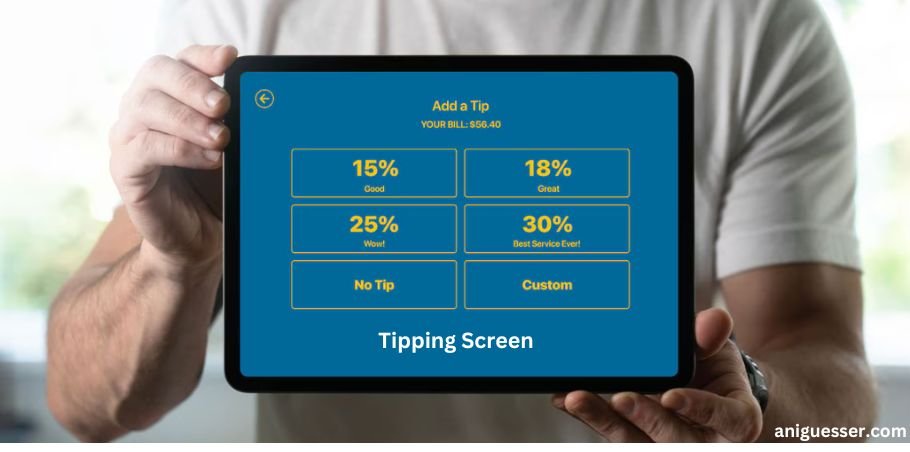Tipping Screen: Navigating the Modern Experience of Digital Gratitude
The tipping screen has quickly become a part of the modern customer service experience. From restaurants to delivery services, these digital prompts are now everywhere, asking us to show our appreciation with a tap of a button. But what exactly is a tipping screen, and how did it rise to such prominence in our daily lives? The shift from cash to card payments and the widespread use of mobile apps have made digital tipping not just convenient, but expected. Let’s explore this evolution and what it means for both customers and workers alike.
The Evolution of Tipping Screen
Traditionally, tipping involved handing over cash to reward service, whether at a restaurant or a hotel. But with the rise of digital transactions, the way we tip has changed. Digital tipping allows customers to quickly select a percentage or a dollar amount using a touchscreen or mobile device. This new norm is often driven by point-of-sale systems that prompt customers to leave a gratuity. As society becomes more cashless, tipping screens are replacing traditional methods, providing convenience but also changing the dynamics of tipping.
Where Do You Encounter Tipping Screens?
Tipping screens are not limited to just restaurants anymore. They have become standard in various industries:
Restaurants and cafes: When paying the bill, customers are often prompted to leave a tip on a screen.
Delivery services: Apps for food delivery services like Uber Eats or DoorDash offer tipping options after an order is delivered.
Ride-sharing apps: Companies like Lyft and Uber prompt customers to tip their drivers digitally after the ride is completed.
Retail environments: Even non-service-based businesses like bakeries or boutique stores may include tipping screens during checkout.
How Tipping Screens Influence Behavior
The presence of tipping screens significantly affects how much and how often customers tip. One of the main psychological drivers behind tipping on these screens is the pressure it creates. Customers often feel compelled to tip when presented with a screen, especially when employees are watching. Businesses also configure these screens to suggest specific tipping amounts, typically higher than what customers would tip unprompted, driving up tip percentages.
The Psychology Behind Tipping Screens
Tipping screens can subtly influence customer behavior through their design. The suggested tip amounts displayed on these screens—often starting at 15% or more—can nudge customers toward higher gratuities. The visual layout and wording of tipping prompts also play a role in decision-making. For instance, showing large buttons for higher tips while making the “no tip” option smaller or less visible can create a sense of obligation. This pressure, whether intentional or not, can lead to a feeling of guilt or embarrassment if a customer chooses to tip less or not at all, especially in face-to-face transactions where the service worker is watching.
The Social Dynamics of Tipping Screens
Tipping screens can change the social dynamic between the customer and the service worker. In group settings, customers may feel additional pressure to tip when others are watching. This can lead to tipping more generously to avoid seeming cheap. On the flip side, tippingscreens remove some of the personal interactions associated with tipping, making it a more detached process.
Pros of Tipping Screens
Tipping screens do offer several advantages:
Convenience: For both customers and businesses, tipping on a screen is quick and simple.
Transparency: Digital tipping can offer clarity about where tips go and how much is collected.
Fair compensation: Service workers can potentially earn more through consistent tipping prompts.
Cons of Tipping Screens
However, tipping screens aren’t without their downsides:
Tipping fatigue: Customers may feel overwhelmed by the frequency of tipping prompts, especially in industries where tipping wasn’t traditionally expected.
Unexpected prompts: Being asked to tip for services that don’t usually require tipping can catch people off guard.
Less personal interaction: The digital nature of tipping removes the human connection that tipping once symbolized.
Tipping Screen Etiquette
With tipping screens becoming so widespread, many customers wonder how much they should tip. Suggested tipping percentages typically range from 10% to 25%, with many screens offering pre-set options to choose from. In casual settings like coffee shops or fast-casual dining, tipping can be more subjective, but etiquette still suggests leaving at least a small amount as a gesture of appreciation.
Impact on Workers
Tipping screens have the potential to positively impact workers by ensuring they receive gratuities for their service. However, there’s ongoing debate about whether digital tips provide fair compensation, especially in industries where wages are low, and workers rely heavily on tips to make a living. It’s important for businesses to ensure that workers receive the full amount of tips collected digitally, without any deductions.
How Businesses Use Tipping Data
Businesses have started to use data from tipping screens to identify trends and improve customer service. By analyzing tipping patterns, companies can see which workers are receiving the most tips and adjust training or policies accordingly. Some businesses also customize tipping options, allowing customers to feel more in control of the amount they give.
Tipping Across Different Cultures
Tipping culture varies widely across the globe, and tipping screens are not as prevalent in all countries. In some cultures, tipping is seen as unnecessary or even offensive. As tippingscreens spread internationally, businesses must be mindful of cultural differences and ensure that their use of tipping prompts aligns with local customs.
Tipping Screen Technology: Improving the Customer Experience
The technology behind tipping screens has evolved to enhance not only business operations but also the customer experience. With modern systems, tippingscreens are now faster, more intuitive, and integrated with payment platforms. Features like personalized tipping suggestions based on past transactions and dynamic tip percentages depending on the service can make the process smoother for regular customers. Additionally, some tippingscreens now allow customers to leave feedback directly, helping businesses improve their services. As this technology advances, it’s likely that tipping screens will become even more user-friendly, further integrating into our everyday transactions.
The Future of Tipping Screens
Looking ahead, tipping screens may continue to evolve. As AI and other technologies develop, we may see more personalized tipping suggestions based on customer preferences or past behavior. Additionally, with the rise of cryptocurrencies, there’s potential for digital tipping to incorporate blockchain technology for secure and transparent transactions.
FAQs about Tipping Screen
Why are tipping screens becoming more common?
Tipping screens are becoming more common due to the rise of digital payments and the convenience they offer to both customers and businesses.
How much should I tip on a screen?
The amount you tip depends on the service, but most tipping screens suggest percentages between 10% and 25%.
Are tipping screens optional?
Yes, tipping screens are optional, but the prompts may create social pressure to leave a tip.
Do workers see all of the tips from screens?
In most cases, yes. However, it’s essential to ensure that the business isn’t deducting fees from workers’ tips.
Can tipping screens be avoided?
In most digital transactions, tipping screens are integrated into the checkout process, but you can usually choose “no tip” if preferred.
Conclusion
Tipping screens have reshaped the way we show gratitude for services. While they offer convenience and consistency, they also introduce new pressures and challenges for both customers and workers. As the trend grows, it’s essential to strike a balance between fair compensation for workers and reasonable expectations for customers. Whether or not tipping screens are here to stay, their impact on modern tipping culture is undeniable.
Share this content:














Post Comment